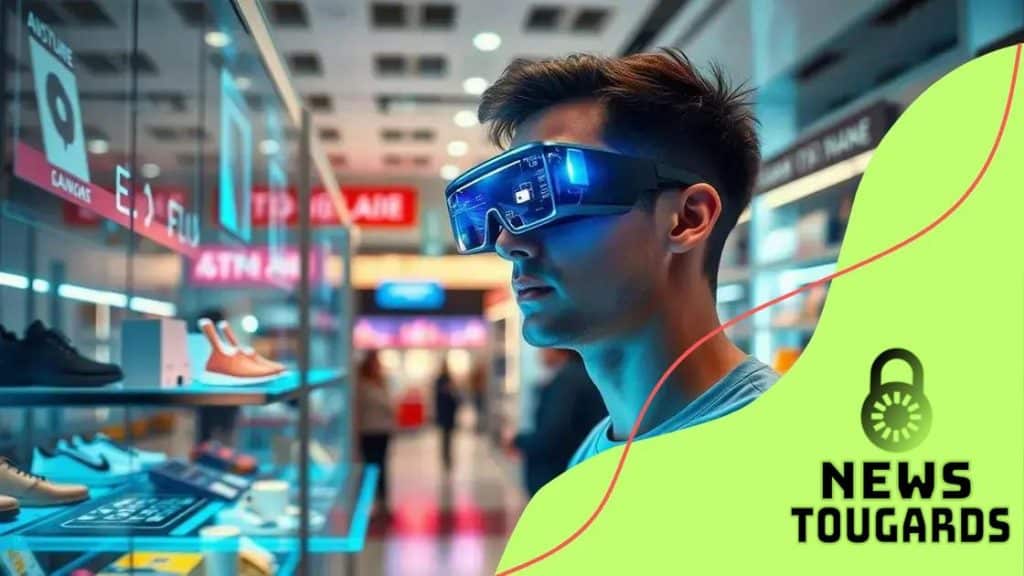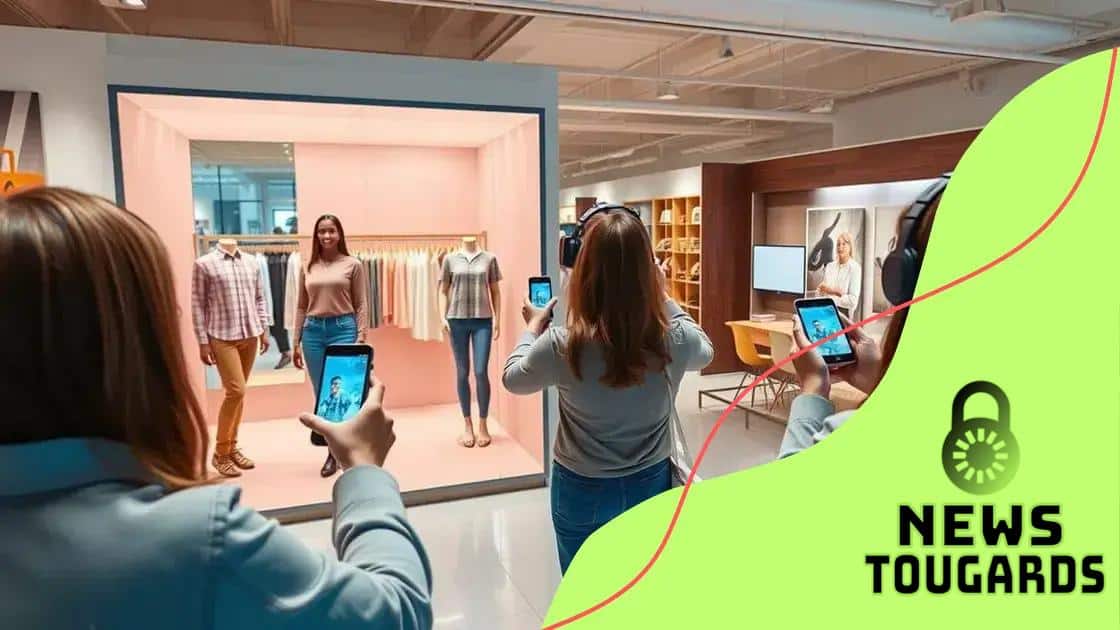The future of augmented reality in retail experiences

The future of augmented reality in retail experiences will enhance customer engagement through interactive technologies like virtual fitting rooms and personalized recommendations, though challenges like technology adoption must be addressed.
The future of augmented reality in retail experiences is here, and it’s reshaping how we shop. Imagine navigating through your favorite store while scanning products for instant information, all through your smartphone. Curious about how this technology could enhance your shopping trips?
Understanding augmented reality in retail
Understanding augmented reality in retail is essential for businesses looking to enhance customer experiences. This technology merges the digital and physical environments, allowing consumers to interact with products in unique ways.
Many retailers are adopting AR to engage shoppers and streamline the buying process. By incorporating AR, companies can create an interactive shopping environment that encourages exploration and discovery.
Benefits of AR in Retail
There are numerous advantages to utilizing AR technology in stores. Here are a few key benefits:
- Enhanced Shopping Experience: Customers can view products in 3D, providing a better understanding of size and features.
- Increased Engagement: Interactive elements draw customers in and keep them interested longer.
- Personalization: AR apps can recommend products based on customer preferences and past purchases.
As augmented reality continues to evolve, retailers are finding new ways to integrate it seamlessly into their physical spaces. From virtual fitting rooms to interactive displays, the possibilities are endless. Customers can visualize how furniture looks in their homes or see clothing fit on their own digital avatars.
AR Technology in Action
Scores of brands are already harnessing the potential of AR to boost customer satisfaction. Examples include furniture retailers offering virtual room placement tools, allowing shoppers to see how a piece fits in their home. Cosmetic brands frequently use AR applications to enable customers to try on makeup virtually.
Despite the exciting prospects, implementing AR in retail also presents challenges. Retailers must invest in technology and educate staff on how to enhance customer service through AR experiences. Overall, understanding and utilizing augmented reality can lead to a dynamic shopping experience that benefits both retailers and consumers.
Benefits of AR for consumer engagement
The benefits of AR for consumer engagement are transforming the retail landscape. By using augmented reality, brands create interactive experiences that captivate customers. Shoppers are no longer passive; they can participate in their purchasing journey in exciting new ways.
Increased Interaction and Interest
One of the key benefits of augmented reality is that it encourages consumers to interact with products before making a purchase. Instead of simply viewing items, customers can try them virtually, increasing interest and attachment to the product.
- Interactive Try-Ons: Customers can see how clothing fits or how furniture looks in their space.
- Engaging Advertisements: AR ads can allow consumers to see products in action.
- Storytelling: Brands can create immersive narratives around their products, making shopping fun.
Furthermore, AR provides personalized shopping experiences tailored to individual preferences. Shoppers can receive recommendations based on their past purchases, which enhances overall satisfaction. Imagine walking into a store and using an AR app that suggests items just for you!
Building Brand Loyalty
Engagement through AR can lead to increased brand loyalty. When customers have fun and memorable interactions with a brand, they are more likely to return. Brands that invest in this technology demonstrate a commitment to innovation and customer satisfaction.
By creating memorable experiences, retailers can set themselves apart. The unique nature of augmented reality helps brands stay top-of-mind, which is crucial in today’s competitive marketplace. As AR technology evolves, the opportunities for enhancing consumer engagement grow, promising a more interactive and rewarding shopping experience for all.
Innovative examples of AR in stores

Innovative examples of AR in stores showcase how technology can transform shopping experiences. Retailers are using augmented reality to engage customers in unique and exciting ways.
Virtual Fitting Rooms
Many clothing retailers offer virtual fitting rooms where customers can try on clothing digitally. This technology allows shoppers to see how outfits would look on them without ever putting them on. Stores like Zara and H&M have implemented these features to enhance customer satisfaction.
- Convenience: Shoppers save time by trying on multiple outfits at once.
- Reduced Returns: Virtual fitting helps customers choose the right size and fit, decreasing the likelihood of returns.
- Engagement: This interactive experience keeps customers interested and entertained.
Another fantastic innovation is the use of AR applications that help customers visualize how products will look in their homes. For instance, furniture retailers like IKEA allow shoppers to place virtual furniture items in their real living spaces. Customers can see how different pieces fit and match their home aesthetics.
Interactive Product Displays
Interactive displays are also becoming a staple in retail environments. Brands use AR to create engaging product demonstrations, allowing customers to see how products work in real-time. For example, beauty brands may offer AR mirrors that allow customers to virtually apply makeup before purchasing.
Additionally, sporting goods stores can display how equipment works through AR, providing customers with comprehensive insights into their purchases. This technology not only demonstrates product features but also encourages customer interaction.
As AR technology continues to develop, it is clear that retailers are just beginning to scratch the surface of its potential. Innovative examples of augmented reality illustrate the exciting future of retail, making shopping a highly engaging experience for consumers.
Challenges in implementing AR experiences
Implementing AR experiences in retail comes with several challenges that brands must navigate. Despite the exciting potential of augmented reality, there are obstacles that can hinder its successful adoption.
Technological Limitations
One key challenge is the technological infrastructure required to support AR. Not all retail environments are equipped with the necessary hardware and software. Retailers need to invest in high-quality displays, devices, and robust networks to facilitate smooth AR experiences.
- High Costs: Setting up AR can be expensive for businesses, especially smaller retailers.
- Device Compatibility: Ensuring that AR applications work seamlessly across different devices can be a complex task.
- Integration Issues: Integrating AR with existing systems may require significant resources and expertise.
Another challenge is ensuring a smooth user experience. If AR applications are slow or difficult to use, customers may become frustrated and abandon the interactive experience. Retailers must prioritize user-friendly interfaces to keep customers engaged and happy.
Consumer Acceptance
Consumer acceptance is also a vital consideration. Not all shoppers are familiar with augmented reality, which could limit its effectiveness. Some customers might be hesitant to try new technology, fearing it may be complicated or unnecessary.
Brands need to educate their customers about the benefits of using AR. Demonstrations, tutorials, and promotional campaigns can help to overcome initial skepticism. Additionally, providing support and assistance while customers explore these new technologies can enhance their experience.
Lastly, data privacy and security concerns can also pose a barrier. Customers are often cautious about sharing personal information or using apps that require access to their devices. Retailers must ensure that they handle user data responsibly and transparently, building trust with their customers.
The future landscape of retail AR technology
The future landscape of retail AR technology looks promising and transformative. As advances in technology continue, augmented reality is expected to become an integral part of the shopping experience. Retailers are already exploring innovative ways to engage consumers using AR.
Seamless Integration
In the coming years, we can expect augmented reality to be seamlessly integrated into various retail environments. This means customers will experience AR not just through apps, but directly through in-store displays and interactive kiosks. Enhanced visuals combined with real-time data will offer shoppers a richer and more informative experience.
- Smart Mirrors: These will allow customers to try on clothing virtually while receiving personalized recommendations.
- Interactive Signage: Retailers will use AR signage that provides engaging product details and promotions.
- Location-Based Experiences: Customers can receive personalized offers and information based on their location within a store.
Additionally, AR technology is set to enhance the online shopping experience. Virtual showrooms will allow customers to visualize products in their homes before purchase. Imagine browsing for furniture while visualizing how it fits into your living space through your smartphone or tablet.
The Role of AI in AR
Artificial Intelligence (AI) will also play a crucial role in the evolution of AR for retail. By analyzing consumer data, AI can help tailor AR experiences to individual preferences. This will lead to more relevant product suggestions and tailored marketing strategies.
Moreover, advancements in machine learning mean that AR applications can become smarter and more intuitive. As technology evolves, retailers will be able to predict consumer preferences and create dynamic visual experiences that keep customers engaged.
The future of retail AR technology promises to change how consumers shop, making it more interactive and enjoyable. As businesses embrace these innovations, customers will likely enjoy shopping experiences that are more personalized and immersive.
In conclusion, the future of augmented reality in retail is bright and full of potential. As businesses integrate AR into their shopping experiences, customers will benefit from more interactive and personalized environments. From virtual fitting rooms to smart mirrors, technology is set to enhance engagement and satisfaction. However, retailers must also address challenges related to technology adoption and consumer education. Overall, embracing AR can lead to a more enjoyable shopping experience.
FAQ – Frequently Asked Questions about Augmented Reality in Retail
What is augmented reality (AR) in retail?
Augmented reality in retail is a technology that overlays digital information and images onto the real world, enhancing the shopping experience.
How can AR improve customer engagement?
AR can create immersive and interactive experiences for customers, making them feel more connected to the products and brand.
What challenges do retailers face when implementing AR?
Challenges include technological limitations, costs, consumer acceptance, and ensuring a smooth user experience.
What does the future hold for AR in retail?
The future of AR in retail looks promising, with advancements in technology leading to more personalized and engaging shopping experiences.





